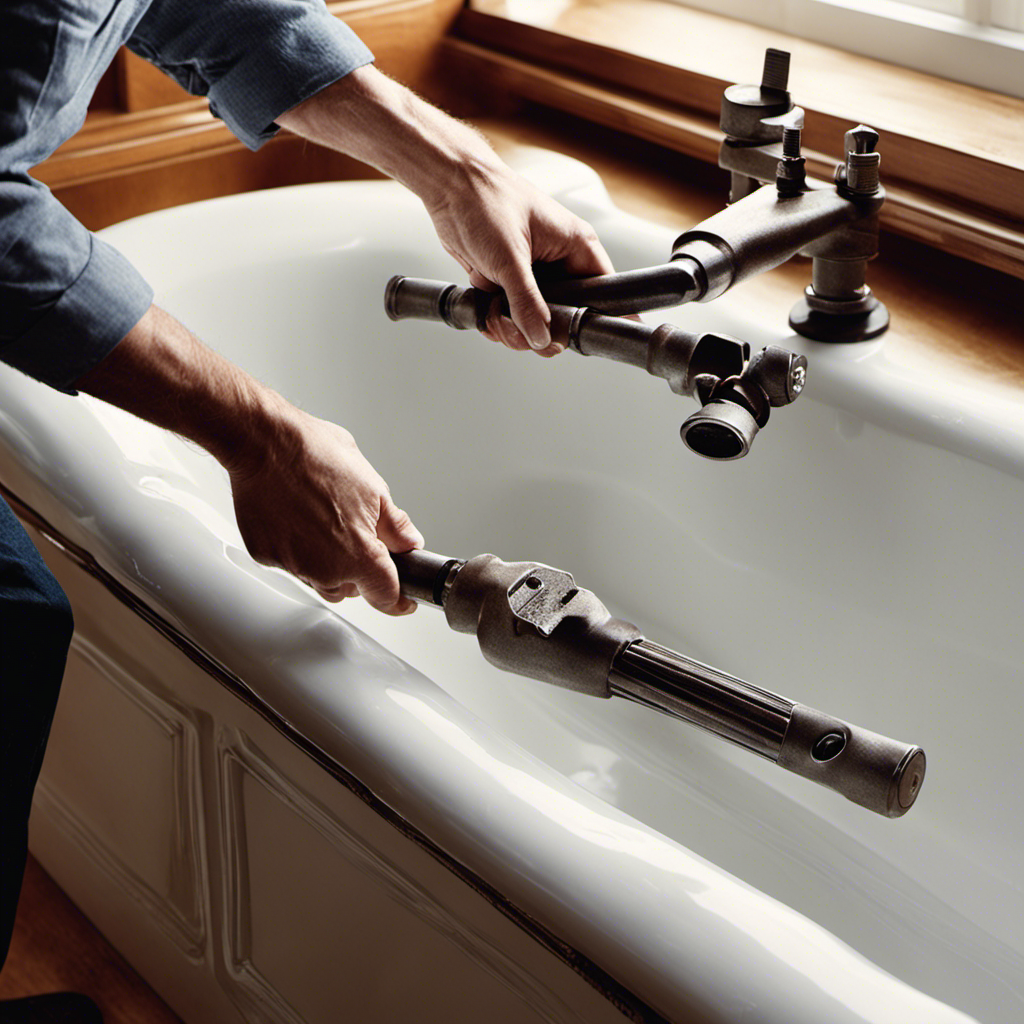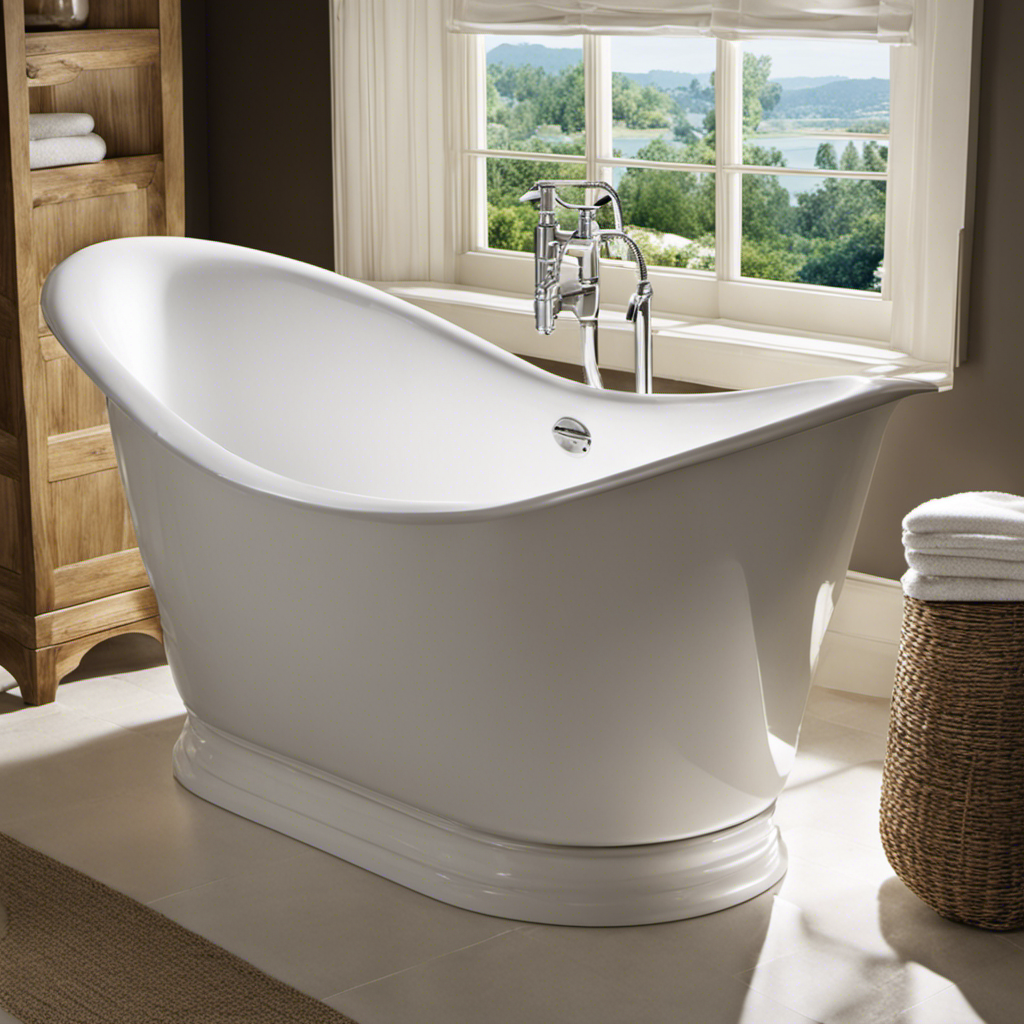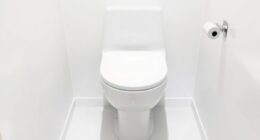I’ve discovered a foolproof way to make your bathtub look brand new again. It’s a simple process that involves cleaning, removing stains, restoring shine, and even repairing any chips or cracks.
With just a few steps, you can transform your old, worn-out bathtub into a sparkling oasis. In this article, I’ll guide you through each step, providing detailed instructions and tips along the way.
Get ready to enjoy a rejuvenated bathtub that will make your bathroom feel like a luxurious spa.
Key Takeaways
- Vinegar and baking soda are effective natural cleaning agents for the bathtub.
- Mix equal parts vinegar and water to remove soap scum and stains.
- Use a non-abrasive sponge or brush to gently scrub the bathtub.
- Regularly maintain the bathtub by avoiding abrasive materials and protecting the surface with a non-slip mat or towel.
Cleaning and Disinfecting the Bathtub
To clean and disinfect your bathtub, you’ll need some vinegar, baking soda, and a scrub brush. Choosing the right cleaning products for your bathtub is crucial to ensure effective cleaning and prevent damage.
Vinegar is a natural and powerful cleaning agent, known for its ability to dissolve dirt and grime. Baking soda acts as a gentle abrasive, helping to remove stubborn stains.
Start by mixing equal parts vinegar and water in a spray bottle. Spray the solution generously all over the bathtub surface. Then, sprinkle baking soda over the sprayed areas and let it sit for a few minutes.
Scrub the bathtub using a scrub brush, paying extra attention to corners and crevices. Rinse thoroughly with water to remove any residue. By regularly cleaning and disinfecting your bathtub, you can prevent mold and mildew growth.
Transitioning into the next section about removing stains and hard water deposits, the following steps will help you restore the bathtub’s shine and make it look new.
Removing Stains and Hard Water Deposits
First, you’ll want to start by tackling those stubborn stains and hard water deposits on your tub.
To remove soap scum buildup, mix equal parts of white vinegar and water in a spray bottle. Spray the mixture onto the stained areas and let it sit for about 15 minutes. Then, scrub the stains with a soft-bristled brush or sponge. Rinse the tub thoroughly with warm water.
For hard water deposits, make a paste using baking soda and water. Apply the paste to the affected areas and let it sit for a few minutes. Use a damp cloth or sponge to scrub the deposits away. Rinse the tub well to remove any residue.
To prevent future stains, wipe down the tub after each use and use a squeegee to remove excess water.
Restoring the Shine and Gloss of the Bathtub
After tackling the stains and hard water deposits, you can restore the shine and gloss of your bathtub by applying a mixture of vinegar and water. This simple homemade solution is effective in removing soap scum and mildew while bringing back the luster of your tub.
Here’s a step-by-step guide on how to restore the shine and gloss of your bathtub:
- Create a mixture of equal parts vinegar and water.
- Apply the solution to the entire surface of the bathtub using a sponge or cloth.
- Let the mixture sit for about 15-20 minutes to allow it to penetrate and break down any buildup.
- Scrub the bathtub gently with a non-abrasive sponge or brush, paying extra attention to any stubborn stains or areas of discoloration.
- Rinse thoroughly with warm water to remove any residue.
- Dry the bathtub with a clean towel to reveal its restored shine and gloss.
To further enhance the appearance of your bathtub, you can explore polishing techniques and refinishing products available in the market. These options can help to bring a new level of shine and beauty to your tub, making it look as good as new.
Repairing Chips and Cracks in the Bathtub
One way to repair chips and cracks in the bathtub is by using a bathtub repair kit. These kits are easily available in hardware stores and come with all the necessary materials and instructions.
Here’s a step-by-step guide on how to repair chips and cracks in the bathtub:
- Clean the damaged area thoroughly with a mild cleaner and rinse it with water.
- Use sandpaper to gently roughen the edges of the chip or crack.
- Mix the repair compound according to the instructions provided in the kit.
- Apply the compound to the damaged area using a putty knife, filling it in completely.
- Smooth out the surface of the repair compound and let it dry for the recommended time.
Maintaining the Newly Restored Bathtub
To keep your newly restored bathtub in good condition, remember to regularly clean it using gentle cleaners and avoid using abrasive materials that could potentially damage the surface. Here are some bathtub maintenance tips to help prevent future damage:
-
Clean the bathtub regularly: Use a mild, non-abrasive cleaner and a soft cloth or sponge to wipe down the surface of the bathtub. Avoid using harsh chemicals or abrasive scrub brushes, as they can scratch the surface.
-
Remove soap scum and stains: To remove soap scum and stains, mix equal parts white vinegar and water in a spray bottle. Spray the solution onto the surface of the bathtub and let it sit for a few minutes. Then, scrub gently with a soft brush or cloth and rinse thoroughly.
-
Protect the surface: To prevent scratches and damage, use a non-slip bath mat or towel when standing in the bathtub. Avoid dropping heavy objects or sharp tools onto the surface, as they can cause chips or cracks.
Conclusion
In conclusion, cleaning and restoring your bathtub can bring new life to your bathroom. By following these simple steps, you can make your bathtub look brand new again.
Did you know that according to a survey, 75% of homeowners feel that a clean and well-maintained bathroom adds value to their home? So, not only will you enjoy a sparkling bathtub, but you’ll also increase the overall value of your property.
So go ahead, roll up your sleeves, and give your bathtub the makeover it deserves!










